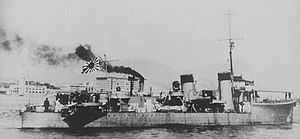HMS Thracian (1920) facts for kids

HMS Thracian in 1941
|
|
Quick facts for kids History |
|
|---|---|
| Name | Thracian |
| Ordered | 1915 |
| Builder |
|
| Laid down | 17 January 1918 |
| Launched | 5 March 1920 |
| Commissioned | 1 April 1922 |
| Identification | Pennant number: D86 |
| Motto | Thrust on |
| Fate | Grounded on 17 December 1941 at Ngan Chau, Hong Kong |
| General characteristics HMS Thracian | |
| Class and type | S-class destroyer |
| Displacement | 1,075 long tons (1,092 t) |
| Length | 276 ft (84 m) o/a |
| Beam | 26 ft 8 in (8.13 m) |
| Draught | 9 ft (2.7 m) |
| Installed power |
|
| Propulsion | 2 Shafts; 2 steam turbines |
| Speed | 36 knots (67 km/h; 41 mph) |
| Range | 2,750 nmi (5,090 km; 3,160 mi) at 15 knots (28 km/h; 17 mph) |
| Complement | 90 |
| Armament |
|
| Name |
|
| Builder | Navy 2nd Construction Department at Hong Kong |
| Acquired | 1942 |
| Commissioned | 1 October 1942 |
| Decommissioned | 1945 |
| In service | 1942–1945 |
| Renamed |
|
| Reclassified | Training ship, 15 March 1944 |
| Reinstated | Returned to Royal Navy in October 1945 |
| Fate | Scrapped, February 1946 |
| General characteristics Patrol Boat No.101 | |
| Class and type | Patrol boat/Training ship |
| Displacement | 1,150 long tons (1,168 t) standard |
| Length | 80.79 m (265 ft 1 in) Lpp |
| Beam | 8.17 m (26 ft 10 in) |
| Draft | 3.01 m (9 ft 11 in) |
| Propulsion |
|
| Speed | 25 knots (29 mph; 46 km/h) |
| Complement |
|
| Sensors and processing systems |
Mk. 23 gunfire control radar (1944) |
| Armament |
|
HMS Thracian was an S-class destroyer built for the Royal Navy during the First World War.
Contents
Description
The S-class destroyers were improved versions of the preceding Modified R class. They displaced 1,075 long tons (1,092 t). The ships had an overall length of 276 feet (84.1 m), a beam of 26 feet 8 inches (8.1 m) and a draught of 9 feet (2.7 m). They were powered by two Brown-Curtis geared steam turbines, each driving one propeller shaft, using steam provided by three Yarrow boilers. The turbines developed a total of 27,000 shaft horsepower (20,000 kW) and gave a maximum speed of 36 knots (67 km/h; 41 mph). The ships carried a maximum of 301 long tons (306 t) of fuel oil that gave them a range of 2,750 nautical miles (5,090 km; 3,160 mi) at 15 knots (28 km/h; 17 mph). The ships' complement was 90 officers and ratings.
Thracian was armed with three QF 4-inch (102 mm) Mark IV guns in single mounts and a single 2-pounder (40 mm) "pom-pom" anti-aircraft gun. The ship was fitted with two twin mounts for 21-inch (533 mm) torpedoes. Two additional single mounts were positioned abreast the bridge at the break of the forecastle for 18-inch (45 cm) torpedoes. All torpedo tubes were above water and traversed to fire.
Construction and career
HMS Thracian was laid down on 17 January 1918 at Hawthorn Leslie and Company, but she was not launched until 5 March 1920 due to financial constraints post-war limitation in naval expenditure. She was completed at Sheerness Dockyard on 1 April 1922.
Battle of Hong Kong
The ship took part in the Battle of Hong Kong in December 1941, commanded by Lieutenant-Commander Arthur Luard Pears. She was the only destroyer defending the colony, after the departure of HMS Scout and HMS Thanet for Singapore on 8 December. On 10 December, she took part in a raid on Japanese crafts attempting to land on Lamma Island. On 13 December, she participated in the evacuation of personnel from Kowloon and Green Island to Aberdeen, Hong Kong Island. On 16 December, she attacked Japanese boats that were preparing for the invasion of Hong Kong Island, but ran aground at Uk Kok. She was refloated later that day and returned to Aberdeen dockyard. Further into the afternoon, she became the target of Japanese high-level bombing. A near miss caused several casualties. With the dockyard badly damaged, the damage Thracian suffered from running aground was considered too bad to fix. On the next day, she was deliberately run aground at Ngan Chau. The crew of Thracian continued to defend the colony as infantry, and would suffer heavy losses in the battle and subsequent captivity. On 24 December, Japanese troops began salvaging the ship, and she was later captured by the Imperial Japanese Army.
On 1 October 1942, she was registered to the naval ship list in the Imperial Japanese Navy, and classified as a special service ship (patrol boat). She was renamed Patrol Boat No. 101. On 25 November, repairs were completed by the Navy 2nd Construction Department, and she was assigned to the Yokosuka Naval District. Afterwards, she spent her time on convoy escort operations in the Yokosuka Area. On 15 August 1943, she was assigned to the torpedo warfare school at Yokosuka. On 15 March 1944, she was classified as the miscellaneous ship (training ship), and renamed Special Training Ship No. 1. She was used for a test bed for new weapons.
By August 1945, she was found in Yokosuka after an unsuccessful scuttling. In December, she was recovered by HMS Undine, only to be broken up in Hong Kong in 1946.



